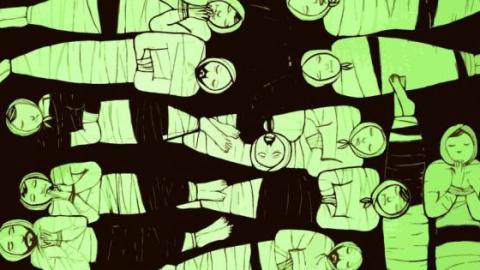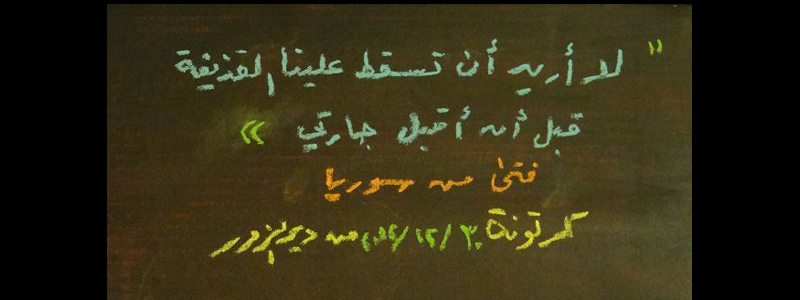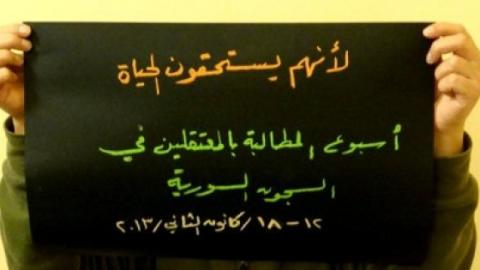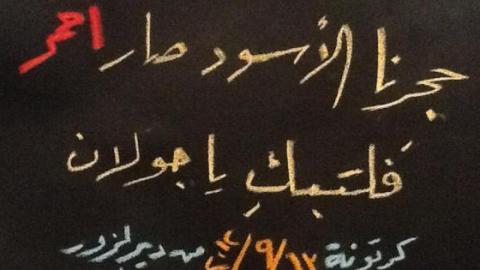The city of Deir ez-Zor in eastern Syria was one of the first towns to join the Syrian uprising soon after Daraa, Banias and Homs. But owing to its distance from the Syrian center of gravity, its struggles have been the least documented in the media in comparison to other Syrian towns.
The city has long suffered negligence due to its geography, located in the midst of the Syrian desert at a great distance to the large urban centers of Damascus and Aleppo. It is also relatively far from borders with neighboring countries, which gave cities like Daraa and Homs an opening to smuggle videos through Lebanon and Jordan to the international media and smuggle journalists back to the towns. The lack of media literacy among the population was also a contributing factor to the lack of media coverage. The few activists with sufficient technological knowledge have attempted to cover this shortage but without much success.
Overcoming the lack of media coverage
To overcome these obstacles, activists in Deir ez-Zor tried to enlist fellow activists and media networks in other towns to help by channeling news about the city. Activists like Abd al-Nasser al-Ayed used his Facebook page on a daily basis to ask readers to share the news he’s posting about Deir ez-Zor with other people. The lack of response has pushed many of these activists to despair of the selfish media strategy that works according to preset agendas. Al-Ayed was forced to eventually leave Deir ez-Zor and escape to Turkey with many videos, photos and news, so that he could directly have access to media organizations in an effort to shed more light on the plight of the city.

Within this context came the project of “A Cardboard from Deir ez-Zor”, as an attempt to break this media lockdown on the city through self-reliance and innovative use of the available technology and mediums. The Facebook page was, according to founding members, “a response to the lack of media attention to the civil struggle in the city, and an attempt to emphasise this primary side of the conflict especially after the increasing militarization in the revolution.” The page’s success has seen its banners/cardboards shared widely by many activists and through several mediums.

The page uses its banner photos as commentaries on the Syrian reality, from solidarity with the detainees to cartons of hastily drawn maps of Syria, representing the fluid reality in the country which leaves no time to contemplate. The idea to use cardboards as main mediums for the group’s banners came after the second invasion of Deir ez-Zor by the Syrian army on June 22, 2012, and its since ongoing siege. The black cardboard, which invites back images of the classrooms with their chalk and blackboards, are meant as an open space for love and hope despite the blackness.
The team running the page had at one point more than 31 activists, only three of which have remained in Deir ez-Zor at the moment. The team also coordinates their campaigns and work with other pages and activist groups including, “Amarji Gathering”, “Coordination Committee for the Revolutionary Youth in Deir ez-Zor” and the “Tuesday for Syrian Freedom Fighters”. This cooperation has resulted in many campaigns including a week dedicated to detainees and one in solidarity with besieged Homs among others.
Cardboards to keep the memory of the revolution alive
Since its early days the one non-negotiable principle for the page has always been the rejection of any sectarian content in its banners. That high sense of self-awareness and civil duty is aptly reflected in many of the cardboards that rejects the sectarian discourse regardless of whom is targeted by it. One fine example of this conviction is the cardboard called “That’s how they want it...” which was directed to the UN envoy to Syria, Lakhdar Brahimi. The group also sarcastically attacked the media organizations that have long ignored the plight of Deir ez-Zor in a famous cardboard stating that: “Every Syrian is a document, but this dictatorship is but a passing news item.”

The cardboards also gave special focus to the issue of Syrians detainees with many banners bearing their names and hometowns, in an effort to keep their memory alive and put pressure on the government to release them. The cardboards also adopted many issues from around the country, not only from Deir ez-Zor. So when the town of al-Hajar al-Aswad was bombarded by the regime’s forces, the page published a cardboard bearing the passage: “Our black stone (al-Hajar al-Aswad) has become a red stone. Let the Golan shed its tears.” The banner was a perfect representation to what the group viewed as the unity of Syrians from Deir ez-Zor to al-Hajar al-Aswad, and the Israeli-occupied Golan Heights.

“We are civilians, in spite of all these guns,” is another telling cardboard from the group. The banner emphasises the peaceful nature and core of the Syrian uprising and its beginnings despite the fact that many have since been forced to carry arms to defend themselves. The page further stresses this view by saying that, “civilians are the basic and most important custodials of the revolution, and their role is central to the steadfastness of the uprising and its ideals.”
The group has also made contact with many different Syrian artists inside and outside the country. The artists showed their solidarity by cooperating with the page on several special cardboards which included: “That’s how they want it...” (Saad Rabie), “A New Caravan of Martyrs” (Mohammad Omran), “My Love and the Massacre” (Farah Hattab) and a beautiful unsigned contribution from a Syrian expat called “We are Not with You in Body, But We are in Spirit.” The page has also accepted all contributions, especially these by children, as long as they did not advocate for sectarianism.
The group’s experiment is but another evidence for the innovative power of Syria’s revolutionaries. In the face of overwhelming odds and hostile media, they were able to deliver their voice in the most eloquent way, and with the simplicity of a cardboard and a pen.



